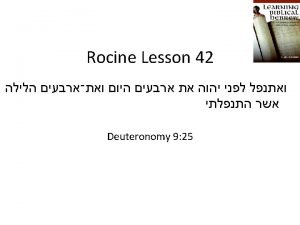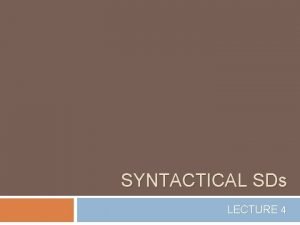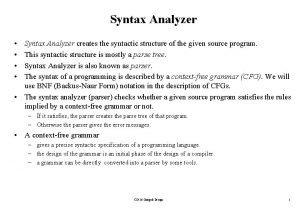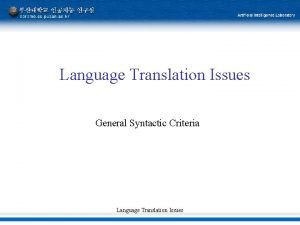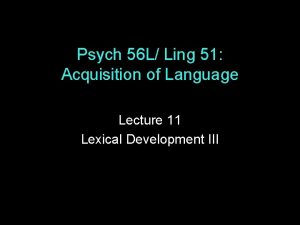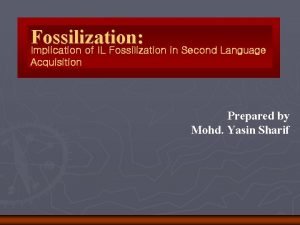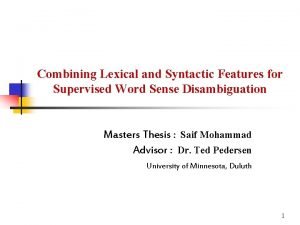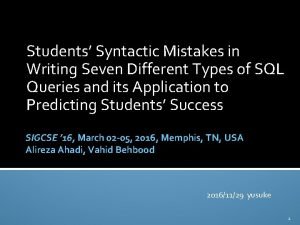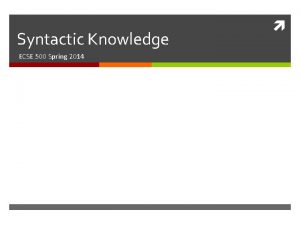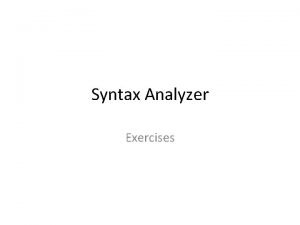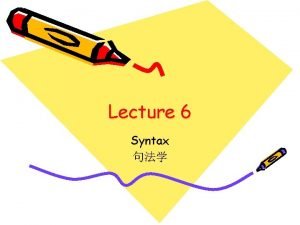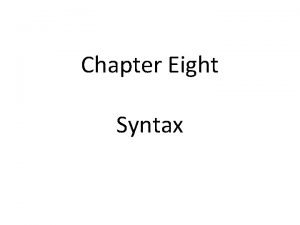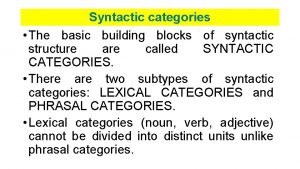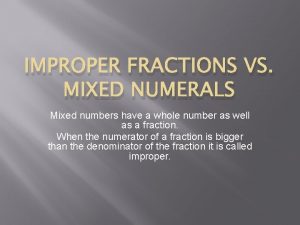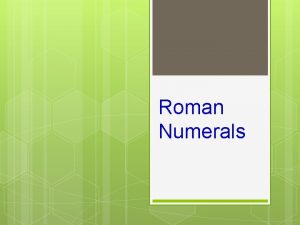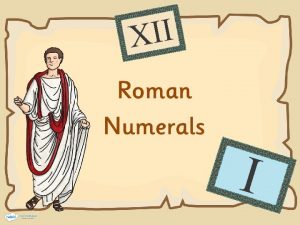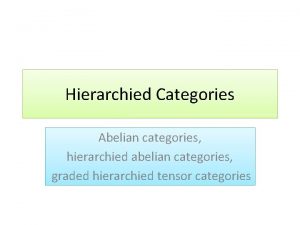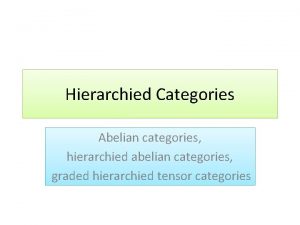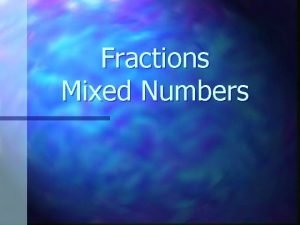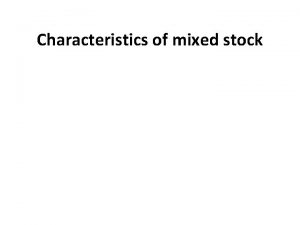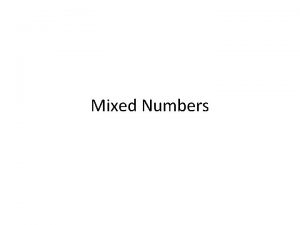Mixed syntactic categories The case of Russian numerals

















- Slides: 17

Mixed syntactic categories: The case of Russian numerals 1) 2) 3) 4) 5) 6) Plan: Introduction to mixed syntactic categories Introduction of Russian numerals Problems of analysis Syntactic gradience theory Possible solution to oblique case problem Conclusions

Mixed syntactic categories in English (1) a. His stupid missing of the penalty lost us the game. b. Him stupidly missing the penalty lost us the game. c. His stupidly missing the penalty lost us the game. How do we categorize English gerund? What is its distribution and its syntactic behavior? How to write phrase-structure rules and to describe agreement?

Basic information about Russian • Russian has 6 cases (some people argue for 7 but the latter one is “unofficial”) • 3 grammatical genders (masculine, feminine and neutral) • Nouns can be singular and plural • Plural nouns don’t have gender marking, i. e. plural is gender neutral • This work is about simple cardinal numerals

One - один (2) a. odin one. NOM. MASC b. odna one. NOM. FEM c. odno • Agrees in gender, number and case boy. NOM. SG • Can also play a role of indefinite article devoʧka • Has the same behavior as adjectives, though the girl. NOM. SG ozero one. NOM. NEUTR d. s mal’ʧik odnim With one. INS. MASC lake. NOM. SG mal’ʧikom boy. INS. MASC distribution is slightly different

Two - два (3) a. dva mal’ʧika Two. NOM. MASC b. dve devoʧki Two. NOM. FEM c. dva With girl. SING. GEN ozera Two. NOM. NEUTR d. S boy. SING. GEN lake. SING. GEN dvum’a devoʧkami two. INS. PL girl. INS. PL • Masculine and neutral have identical forms and these are different from femnine (some people say it’s feminine and non-feminine in case of two) • Noun that follows two has features [SING, GEN]. This is true when the phrase is in Nominative case or Accusative case • In oblique cases, the agreement works just like in adjectives and noun becomes plural with the respective case

Three and four – три и четыре (4) a. Tri • No gender marking • Same noun case as in previous case • This and previous categories can all reflect animacy of noun in Accusative case, as in examples (4 d) and (4 e) mal’ʧika Three boy. SING. GEN b. Tri devoʧki Three girl. SING. GEN c. Tri ozera Three lake. SING. GEN d. Ja priglasil tr’eh gostei I invited three. ACC. ANIM guests. ACC e. Ja I viʒu tri mosta see three. ACC. INANIM bridge. ACC

From five to twenty – от пяти до двадцати (5) a. Pjat’ Five b. Sem’ Seven malʧikov boy. GEN. PL devoʧek girl. GEN. PL c. Dvenadtsat’ Twelve oz’er lake. GEN. PL • Noun following a numeral is now in its plural form • Doesn’t mark gender in any way

Hundred – сто (6) a. Sto mal’ʧikov (one) hundred boy. GEN. PL b. devoʧek Sto (one) hundred girl. GEN. PL с. oz’er Sto (one) hundred lake. GEN. PL • Hundred has many forms, like сотня or some other archaic forms • If we speak about this alternative form or about archaic forms, they also have a plural version

Thousand – тысяча (7) a. Tɨs’aʧa Thousand. NOM. SG b. Eta This. NOM. FEM c. Dve Two. NOM. FEM d. P’at’ Two. NOM. FEM devoʧek girl. GEN. PL tɨs’aʧa devoʧek thousand. NOM. SG girl. GEN. PL tɨs’aʧi devoʧek thousand. GEN. SG girl. GEN. PL tɨs’aʧ devoʧek thousand. GEN. PL girl. GEN. PL • Thousand takes an agreeing determiner as in (7 b). All the previous cases would just take eti which is plural with unspecified grammatical gender • Thousand has its own plural form as in (7 c) and (7 d)

Million - Миллион (8) a. Million rublei Million. NOM. SG b. Etot This. MASC. SG c. Dva Two. NOM. MASC d. Dvenadtsat’ Twelve • Similar situation to thousand, but million is masculine rouble. GEN. PL million rublei million. NOM. SG rouble. GEN. PL milliona rublei million. GEN. SG rouble. GEN. PL millionov rublei million. GEN. PL rouble. GEN. PL

Summary of numerals From: G. G. Corbett “Problems in the Syntax of Slavonic Numerals”, in The Slavonic and East European Review, 1978

Syntactic gradience • Uses the idea of fuzzy sets. • Different words may have a different degree of “nouniness”, “adjectiveness”, etc. than others. Compare of utter and thin in English. • Allows for element to have properties from two sets of categories at the same time. • Can be either Intersective or Subsective.

Intersective gradience formalism If α, β are form classes characterized by syntactic properties {a 1…am} and {b 1…bn}, respectively; and ∃X, X a grammatical formative, which conforms to a set of syntactical properties {c 1…cp}; such that {c 1…cx} ⊂ {a 1…am} and {cx+1…cp} ⊂ {b 1…bn}; then α and β are in an intersective gradient relationship with respect to X, and its projection XP. From: Aarts, Bas. 2007. Syntactic Gradience: The Nature of Grammatical Indeterminacy. Oxford University Press.

Intersective gradience formalism A = {a 1…an} N = {n 1…nm} Num = {num 1, num 2, num 3, num 4, num 5, num 6, num 7} {num 1, num 2, num 3, num 4} ⊂ A {num 5, num 6, num 7} ⊂ N In this formalism, numerals’ category is weakly converging to the category of adjectives, since subset of A is larger than subset of N

Oblique Case Problem a. Mɨ govorim s trem’a devoʧkami We speak with three. INS girl. INS. Pl b. On govorit s tɨs’aʧei ljudei He speaks with thousand. INS. SG people. GEN. Pl If ((Card. A(Num) ≤ 2) ∧ (Case = Oblique)) ∨ (Case = Direct)): Numeral has noun-like behavior in agreement Else: Numeral has adjective-like behavior in agreement

AP and Num. P agreement a. Dva poslednih seminara Two. NOM. MASC last. GEN. Pl seminar. GEN. SG Num + AP + NP b. Pjat’ poslednih seminarov Five. NOM last. GEN. Pl seminar. GEN. Pl Num + AP + NP c. Poslednie dva seminara Last. NOM. Pl two. NOM. MASC seminar. GEN. SG AP + Num + NP d. Poslednive pjat’ seminarov Last. NOM. Pl five. NOM seminar. GEN. Pl AP + Num + NP Adjective agrees with the noun, which is Genitive and thus adjective becomes Genitive Adjective agrees with the whole Num. P, which is Nominative and thus adjective also takes Nominative case

Conclusions and questions • Syntactic gradience can be useful in some syntactic models. • Conditioning syntactic behavior based on how many X-like properties a word has. • How many fundamental syntactic categories are there? • Are there universal tendencies (both diachronic and synchronic) in syntactically gradient categories?
 How to determine syntactic categories
How to determine syntactic categories Best worst and average case
Best worst and average case Hitpael verbs
Hitpael verbs Polysyndeton
Polysyndeton Left factoring
Left factoring Syntactic criteria
Syntactic criteria Syntactic sugar causes cancer of the semicolon
Syntactic sugar causes cancer of the semicolon Syntactic bootstrapping
Syntactic bootstrapping Language fossilization definition
Language fossilization definition Lexical vs syntactic ambiguity
Lexical vs syntactic ambiguity Syntactic features
Syntactic features Syntactic features
Syntactic features Syntactic mistakes
Syntactic mistakes Syntactic knowledge
Syntactic knowledge Syntactic analysis exercises
Syntactic analysis exercises Syntactic function examples
Syntactic function examples Symbols used in syntactic analysis
Symbols used in syntactic analysis Pragmatic cue
Pragmatic cue


